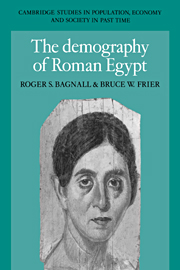Book contents
- Frontmatter
- Contents
- List of figures
- List of tables
- Foreword
- Preface
- A note on references and abbreviations
- 1 The census returns
- 2 The census returns as demographic evidence
- 3 Households
- 4 Female life expectancy
- 5 Male life expectancy and the sex ratio
- 6 Marriage
- 7 Fertility
- 8 Migration
- 9 Conclusion
- Catalogue of census declarations
- Catalogue of census declarations Supplement
- Appendixes
- Bibliography
- Index
- Cambridge Studies in Population, Economy and Society in Past Time
7 - Fertility
Published online by Cambridge University Press: 06 January 2010
- Frontmatter
- Contents
- List of figures
- List of tables
- Foreword
- Preface
- A note on references and abbreviations
- 1 The census returns
- 2 The census returns as demographic evidence
- 3 Households
- 4 Female life expectancy
- 5 Male life expectancy and the sex ratio
- 6 Marriage
- 7 Fertility
- 8 Migration
- 9 Conclusion
- Catalogue of census declarations
- Catalogue of census declarations Supplement
- Appendixes
- Bibliography
- Index
- Cambridge Studies in Population, Economy and Society in Past Time
Summary
High mortality placed a heavy burden on Egyptian women; this population's survival depended upon sustaining relatively high overall fertility. As E. A. Wrigley has observed, in societies with very high mortality, “a population could hardly allow private choice since it must mobilize maximum fertility if it is to survive at all.” Roman Egypt typifies such populations. However, as we shall see below, Wrigley's observation must be qualified. Mobilizing “maximum fertility” was certainly not a demographic goal in Roman Egypt; and restraints on fertility, though different in kind and operation from those used after the modern fertility transition, played a major part in the general social survival of Egypt's population.
Overall female fertility
In 211 instances, census returns preserve the age both of a mother and of her child. In these instances, the age of the mother at childbirth can be reconstructed by subtracting the child's from the mother's age, as we have done in Table C. The results for ages 12 to 49 are plotted in Figure 7.1 (p. 137), with four-year moving averages used to smooth the figures. As the graph shows, the peak period of an Egyptian woman's fertility lies between ages 17 and 30; thereafter the number of known births drops off. This graph strikingly confirms the argument in Chapter 6 (at notes 7–9) that Egyptian women married at an early age, usually by their later 'teens.
However, the curve in Figure 7.1 needs adjustment. We want to know the probability that a woman will bear a child at a given age.
- Type
- Chapter
- Information
- The Demography of Roman Egypt , pp. 135 - 159Publisher: Cambridge University PressPrint publication year: 1994
- 1
- Cited by



